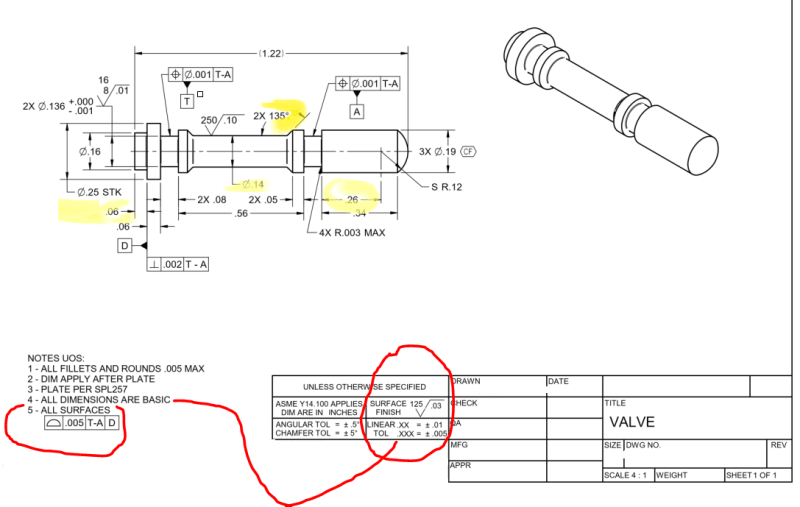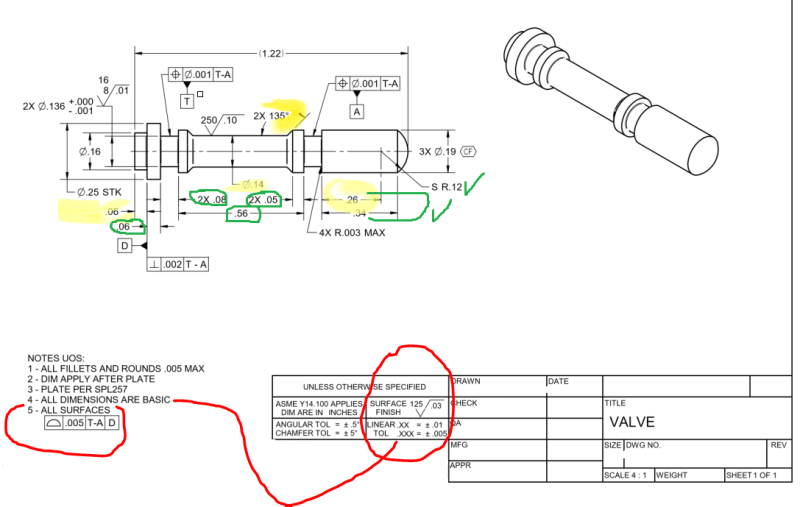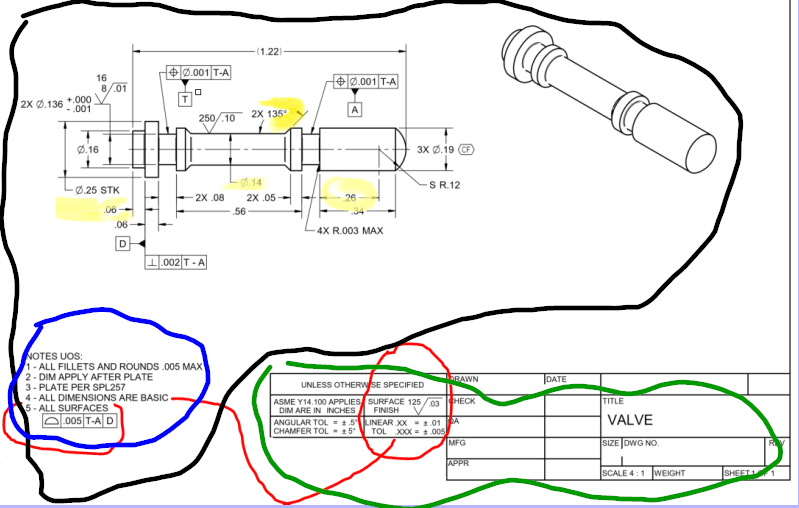Couple of questions:
1.) If drawing shows ASME Y14.100 only, should I understand that rule#1 is enforced? Or only if ASME Y14.5 invoked directly (shown on the face of the drawing) implies envelope principle being in charge?
2.) How to interpret what tolerances are applicable to the dimensions in yellow:
a.) 135° angle is basic or is subject to angular tolerances shown in the title block ±5°
b.) Which dimensions are subject to linear tolerance xx = ±.01 and xxx = ±.005? I underlined in yellow some of the examples, but you can chose any dimensions shown on this print.
c.) By the same token as point b.), which dimensions are subject to chamfer tolerance = 5° (title block tolerance)? Is ±5° tolerance applied to 2X 135°?
Full disclaimer. This drawing is from an ASME training material from a rebutable source (and I am NOT assuming "the source" is NOT correct), therefore I am not thinking that the source/the author is not aware about the Y14.5 statement on 2.1.1.2 /ASME Y14.5-2009
b.) specifying on the drawing (or in a document referenced on the drawing) a general note such as: UNTOLERANCED DIMENSIONS ARE BASIC. See Fig. 7-1, illustration (c).
NOTE: Where using this method a plus/minus general tolerance is not allowed.
or 5.1.1.2 from ASME Y14.5-2018
b.) specifying on the drawing (or in a document referenced on the drawing) a general note such as “UNTOLERANCED DIMENSIONS ARE BASIC.” See Figure 10-1, illustration (c).
NOTE: When using this method, a plus/minus tolerance is notallowed via a general tolerance block or notes.

1.) If drawing shows ASME Y14.100 only, should I understand that rule#1 is enforced? Or only if ASME Y14.5 invoked directly (shown on the face of the drawing) implies envelope principle being in charge?
2.) How to interpret what tolerances are applicable to the dimensions in yellow:
a.) 135° angle is basic or is subject to angular tolerances shown in the title block ±5°
b.) Which dimensions are subject to linear tolerance xx = ±.01 and xxx = ±.005? I underlined in yellow some of the examples, but you can chose any dimensions shown on this print.
c.) By the same token as point b.), which dimensions are subject to chamfer tolerance = 5° (title block tolerance)? Is ±5° tolerance applied to 2X 135°?
Full disclaimer. This drawing is from an ASME training material from a rebutable source (and I am NOT assuming "the source" is NOT correct), therefore I am not thinking that the source/the author is not aware about the Y14.5 statement on 2.1.1.2 /ASME Y14.5-2009
b.) specifying on the drawing (or in a document referenced on the drawing) a general note such as: UNTOLERANCED DIMENSIONS ARE BASIC. See Fig. 7-1, illustration (c).
NOTE: Where using this method a plus/minus general tolerance is not allowed.
or 5.1.1.2 from ASME Y14.5-2018
b.) specifying on the drawing (or in a document referenced on the drawing) a general note such as “UNTOLERANCED DIMENSIONS ARE BASIC.” See Figure 10-1, illustration (c).
NOTE: When using this method, a plus/minus tolerance is notallowed via a general tolerance block or notes.



